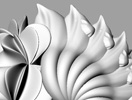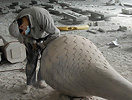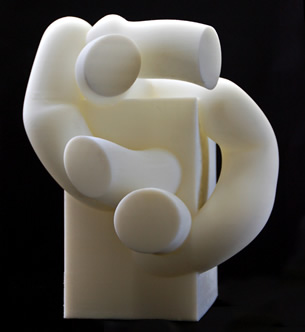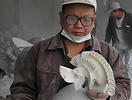Stone Sculptures Blend Art and Technology
Western artists -- in concert with Chinese craftsmen -- realize fine art is not possible without digital and rapid prototyping.
Latest News
December 3, 2008
By Susan Smith
 While Autodesk (San Rafael, CA) is not a rapid prototyping company, its digital prototyping software is used for manufacturing and most recently for the design of stone sculptures. For the Digital Stone Exhibition held in China, the four Western artists Bruce Beasley, Jon Isherwood, Robert Michael Smith, and Kenneth Snelson used 3D printing with their models created in Autodesk Inventor to fashion the form they envisioned — in many cases, a form they couldn’t achieve without the digital input.
While Autodesk (San Rafael, CA) is not a rapid prototyping company, its digital prototyping software is used for manufacturing and most recently for the design of stone sculptures. For the Digital Stone Exhibition held in China, the four Western artists Bruce Beasley, Jon Isherwood, Robert Michael Smith, and Kenneth Snelson used 3D printing with their models created in Autodesk Inventor to fashion the form they envisioned — in many cases, a form they couldn’t achieve without the digital input.
The exhibition, which showcases the blend of art and technology, is a venue for these artists who can demonstrate the digital technologies of the West with traditional stone craftsmanship of the East. The sculptures are all individually crafted pieces which technically represent the digital and prototyped model.
The artists began with Autodesk design tools to shape their sculptures digitally without having to cut any stone. Then the digital prototypes were sent to a 3D printer for a rapid prototype to be made. This prototype was then used by some of the finest stone carvers in China to scale the design to a large piece of stone.
 Chautauquantumandal (3d Model) by Robert Michael Smith |  Base Station (3D model): Kenneth Snelson |
 Singers of Tales (carving process): Jon Isherwood |
|
The idea for the exhibition started two years ago when Bay Area resident Bruce Beasley was invited to speak at AutodeskUniversity. CEO Carl Bass, also a furniture designer, admired some of Beasley’s work designed in Autodesk software and was amazed at what he could do with it. The exhibition was born from the two men’s intention to show not only the final sculpture but the process by which they were created.
Alissa Perlstein, director, worldwide education marketing for Autodesk, said the exhibition is two-pronged: the first are the final stone pieces, of which there are 20, five from each of the four artists. The other half is the digital creative process: “That’s really a behind-the-scenes look at what the artist goes through, from the very beginning of conceptualizing the idea for a sculpture to printing this rapid prototype of the concept so they can see how it’s going to look, the aesthetic and scale, to the actual carving of it,” said Perlstein.
Part of the exhibition displays a 3D printer, rapid prototypes, models, and animations. A documentary also shows the entire process over the year and a half of creation. In addition, local artists that work with design software sent their models to the printer, and their pieces were included in the exhibition as well.
Hosting the exhibition in China was a “natural fit,” according to Perlstein. The artists partnered with a carving company in southern China known for their expertise and craftsmanship in stone carving. “There’s an emerging contemporary art community in China,” said Perlstein.
The exhibition opened in October in Beijing and is now open in Shanghai, and will move to Chongqing in December. Autodesk held Autodesk University in China the first week of November, aligning the opening of the exhibition in Shanghai with the event.
One of sculptor Robert Michael Smith’s passions is taking inspiration from nature and animals and contorting them. The technology allows the artist to play, as the software allows him to twist, shape, and stretch digital material. By not being bound by a physical material such as stone, artists are able to quickly get at a concept that is either working or not working for them, and try out many different concepts and intersections. This saves an enormous amount of time and allows them to form shapes they wouldn’t attempt without the software.
 Challenge (rapid prototype): Bruce Beasley |
An important element in the design of sculpture is the center of gravity. The pieces for the exhibition are all granite, very heavy, and approximately six feet tall. The museum space chosen had to accommodate the weight of the pieces, so they are located outside. The software also helps with the analysis of center of gravity, shipping the piece, and how it is to be assembled onsite.
The rapid prototype is a small physical prototype printed in a 3D printer, made of plastic. According to Perlstein, not only is this model far less expensive than carving a small scale stone carving, it’s very accurate. “The 3D printer prints a small form about 18 square inches, then you have this model you can hold in your hand, and it’s extremely light. You understand how it’s going to look, you can spin it around and see what it looks like from all angles.” The small physical prototypes were given to the Chinese carving company, which scaled the pieces by hand to carve the final large sculptures.
“It’s better to make mistakes in electrons, than in granite,” said Beasley. Beasley added that the ability to design digitally is very liberating because it allows him to play with shapes and design in a way that’s more freeing than working with a physical prototype.
He’s also worked with materials such as aluminum and steel, and he sees software and 3D printing as tools to help arrive at the right design. The space that some materials take up is also not an issue with technology.
Digital sculpture is not the only place Autodesk is using rapid prototyping to augment their digital prototyping initiative. In a keynote at Autodesk University 2008, Carl Bass announced that Autodesk, in cooperation with Stratasys, a 3D printing company, has printed a large full-scale model of a motorcycle design in Inventor using their 3D printer, made with multiple materials. Autodesk also recently announced a partnership with Z Corporation.
Autodesk, Inc.
San Rafael,CA
Subscribe to our FREE magazine, FREE email newsletters or both!
Latest News
About the Author
DE’s editors contribute news and new product announcements to Digital Engineering.
Press releases may be sent to them via [email protected].







